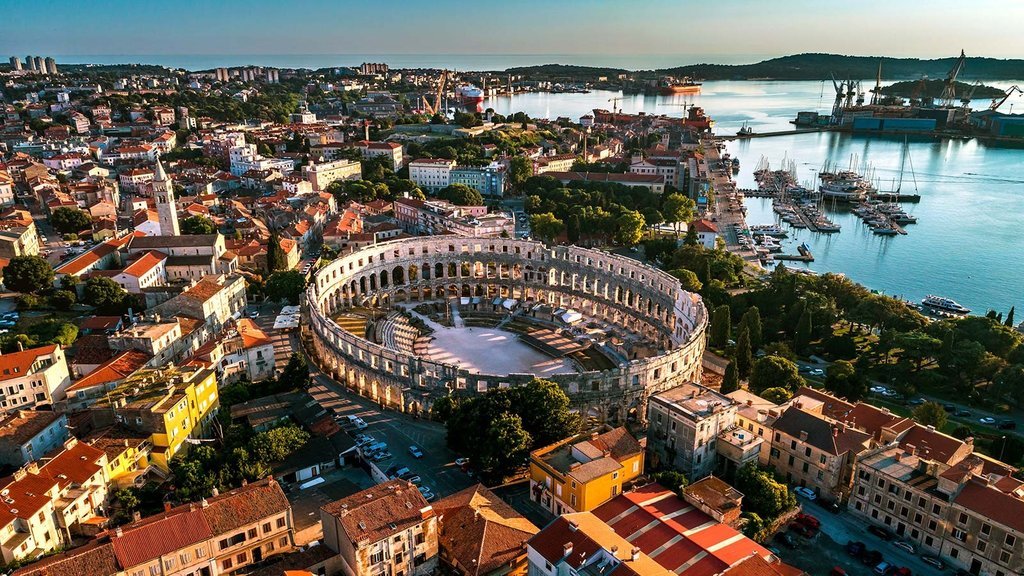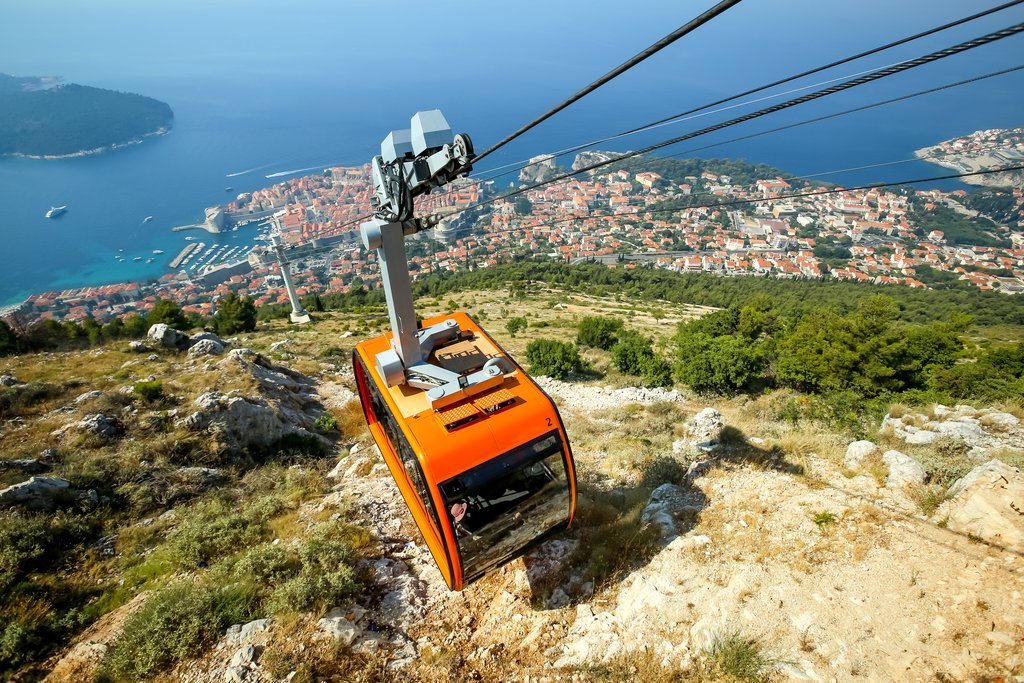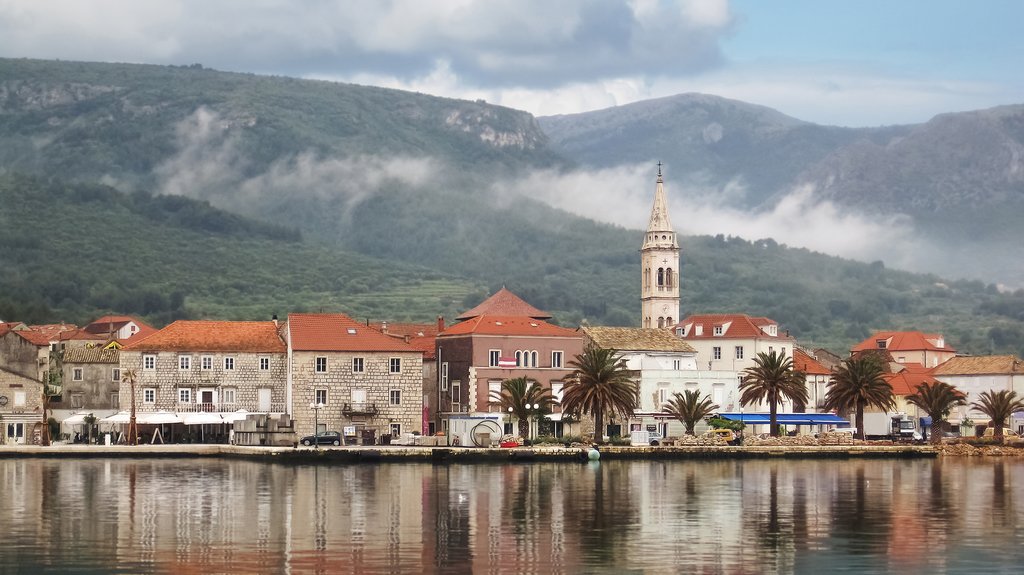Highlights
- Visit the must-see 6th-century Basilica of Euphrasius in Poreč
- Navigate the maze of narrow stone streets on the eclectic island-city of Trogir
- Cycle through olive groves and vineyards and past coastal villages on Hvar
- Drink Grk wine in Marco Polo's hometown on Korčula
- Watch the sunset over the Elafiti Islands from Srđ Mountain in Dubrovnik
Brief Itinerary
| Day | Highlights | Overnight |
|---|---|---|
| Day 1 | Welcome to Zagreb! | Zagreb |
| Day 2 | Zagreb to Rovinj, Stopping in Pula | Rovinj |
| Day 3 | Explore Istria: Poreč & Motovun (Day Trip from Rovinj) | Rovinj |
| Day 4 | Rovinj to Šibenik, Stopping at Zadar | Šibenik |
| Day 5 | Šibenik to Split, Stopping in Trogir | Split |
| Day 6 | Explore Split | Split |
| Day 7 | Ferry from Split to Hvar, Cycle through Villages & Vineyards | Hvar Town |
| Day 8 | Ferry from Hvar to Korčula | Korčula Town |
| Day 9 | Korčula to Ston via Pelješac Peninsula | Ston |
| Day 10 | Ston to Dubrovnik, City Walls & Sunset from Srđ Mountain | Dubrovnik |
| Day 11 | Depart Dubrovnik |
Detailed Itinerary
Day 1: Welcome to Zagreb!

Start your adventure from Zagreb, the capital of Croatia. Upon arrival at the airport, you'll be transferred to your hotel to settle in. The rest of the day is yours to spend as you like. The city center is easily walkable and the streets and parks are easy to navigate by foot. All the main attractions and restaurants are within walking distance.
A gem of a European city, Zagreb is at once historic and new. It's filled with leafy green parks and gothic/neo-renaissance buildings, yet there's also modern shopping complexes, outdoor malls, and endless dining and drinking options. Consider heading out on a guided walking tour of the historic heart of the city. This involves walking from the main square to Zagreb's Upper Town and passing through local markets before reaching St. Mark's Square.
Alternatively, you can visit one of the many museums and art galleries, like the Homeland War Museum, the Nikola Tesla Technical Museum, or the ever-popular Museum of Broken Hearts. Or stroll through the city center, enjoying 17th-century neo-baroque architecture found at Zagreb's Art Pavilion and Croatian National Theater.
Zagreb also has a number of beautiful city parks which are great for exploring and people watching, especially in the late afternoon. Maksimir is a great option, with a variety of cafés nearby to pick up a coffee for your stroll.
Day 2: Zagreb to Rovinj, Stopping in Pula

Get an early start this morning to make the scenic drive west to Rovinj, stopping first in historic Pula. Its strategic location at the southern tip of the Istrian peninsula means it has been occupied many times throughout the centuries by everyone from the Romans to the Allied Forces in WWII. While Pula is known for its beaches and harbor, it's most famous for its Roman amphitheater, the Pula Arena, which dates back to the first century.
Take your time to explore the city. You'll no doubt want to make a beeline for the arena, which is one of the 10 largest colosseums the Romans ever built. Stand in the tunnels and corridors where warriors and lions were kept before entertaining crowds of up to 25,000. But that isn't all—there are many other ruins you can visit here. These include the Arch of the Sergii—an ancient Roman arch dating to 29 BCE—and the Temple of Augustus, a Roman temple built in 2 BCE.
When it's time, continue along the coast to Rovinj where you'll settle into your accommodation before taking the rest of the afternoon and evening to explore this small jewel on the west coast of Istria.
Though Rovinj remains an active fishing port today, it wasn't until 1763 that it became part of the mainland. As such, its restricted access resulted in the labyrinth of narrow, cobblestoned streets you see today. Explore Old Town and marvel at the centuries-old Venetian influenced architecture as you pass under archways, through alleyways, and up stone stairwells. Navigate your way to Balbi's Arch and the 12th-century Town Clock, noting Rovinj's skyline dominated by the baroque St. Euphemia Church.
Seek out your choice of interest from churches to galleries and pebbled beaches, capping off the day with a delicious dinner of fresh fish and local wines, like Teran and Malvasia.
Driving time (Zagreb to Pula): 3 hours
Driving time (Pula to Rovinj): 45 minutes
Day 3: Explore Istria: Poreč & Motovun (Day Trip from Rovinj)

Take the day to experience more of Istria from coastal Poreč to hilltop Motovun.
Located on the western coast of the Istrian Peninsula, Poreč is a popular resort town, home to labyrinthine streets and a historic stone-housed core that remains relatively untouched by tourism. Its main draw, however, is the important Romanesque Basilica of Euphrasius, Istria's must-see ecclesiastical attraction. The 6th-century Byzantine basilica is the central component of a complex that includes the bishop's palace, an atrium, baptistry, and campanile, all of which are UNESCO-protected.
Venture inside through the arcaded atrium to discover the centuries of history and marvel at the intricate golden mosaics that adorn the apse and the triumphal arch. Ascend the campanile for views over Poreč's red roof tiles before making your way to Dekumanska, a pedestrian-only thoroughfare that runs across the center of the Old Town. From one end to the next you can visit the 15th-century Venetian tower and the 13th-century Romanesque House with its unusual projecting wooden balcony.
Finally, head inland to explore Motovun, an ancient sleepy town that sits atop a 909-foot (277 m) hill. Its present appearance, with the city walls surrounding the center of the town, dates back to the Middle Ages. Leading from Motovun's Venetian-inspired town square up to the top of the hill is the longest staircase on the Istrian Peninsula, which boasts 1,052 steps. If you choose to make the climb you'll be treated to panoramic views of the vineyards and forests that lie outside the village walls.
The vineyards produce Croatia's famed Teran and Malvasia wines while the forests are home to hidden treasures: black and white wild truffles, which are prized among foodies across the globe. Sample local wines and enjoy a meal with truffles sourced from the nearby truffle-rich forests.
Driving time (Rovinj to Poreč): 45 minutes
Driving time (Poreč to Motovun): 40 minutes
Driving time (Motovun to Rovinj): 1 hour
Day 4: Rovinj to Šibenik, Stopping at Zadar

Today you'll spend time exploring the Adriatic coast as you make your way from Rovinj down to Šibenik. On your way, consider breaking up the trip with a stop in Zadar.
Set on a peninsula surrounded by the sparkling Adriatic Sea, Zadar is a tidy network of polished stone streets and public squares—the Roman forum dating back to the 1st century CE as an example. Explore the historic center starting at the Sea Organ, passing the 12th-century cathedral and the Church of St. Simeon. Stop for lunch with a glass of wine in the center of town at a konoba restaurant like Stomorica, which is popular for its grilled fish and simple Dalmatian cuisine.
From Zadar, you'll continue along the coast to Šibenik. A true Croatian town founded by the Croat king Petar Krešimir IV in the 11th century, Šibenik is home to impressive fortresses, music festivals, and medieval gardens. Start with a visit to the famous UNESCO-protected St. James' Cathedral, before selecting a restaurant for your dinner—perhaps Pelegrini, a Michelin Star restaurant and wine bar just above the cathedral.
Driving time (Rovinj to Zadar): 4 hours
Driving time (Zadar to Šibenik): 1 hour
Chat with a local specialist who can help organize your trip.
Day 5: Šibenik to Split, Stopping in Trogir

Set on a small island, a stepping stone between the mainland and the much larger Čiovo is the ancient coastal city of Trogir. It's a small place, and it doesn't take longer than about five minutes to walk from any point in Trogir's historic center to reach the sea. Navigate the narrow stone streets, starting with the Garagnin-Fanfogna Palace, working your way to the Cathedral of St. Lawrence to admire Radovan's 13th-century Romanesque portal and the bizarre creatures around the doorposts.
Stroll along the Riva, admiring the Romanesque, Renaissance, and baroque architecture and medieval fortress walls as you find your way to the 15th-century Kamerlengo Fortress. Ascend its ramparts for sweeping views over the island. And don't be surprised if you're serenaded by traditional acapella groups called klapa, along your way.
Come mid-afternoon, travel the short distance east to Split, settling into your hotel before taking the rest of the afternoon to wander its historic center.
Start at Pjaca Square for pretty views of white marble tiles, the Iron Gate (the western entrance to Diocletian's Palace), a Romanesque clock tower with the remains of a medieval sundial, and the 15th-century Town Hall. Stop for lunch at Trattoria Bajamont, just north of the Iron Gate. From there, visit the popular Voćni trg or Fruit Square. Here you can enjoy renaissance architecture, influenced during Split's Venetian era. For a bit of shopping and a bite to eat head to Marmont Street, though you'll want to make your way to the waterfront to catch the sunset.
In the evening, take a stroll along Split's seafront Riva to admire the views over the Adriatic before finding the off-beat Konoba Dioklecijan restaurant, just to the left of the Bronze Gate for dinner, its outdoor terrace built into the walls of Diocletian's Palace.
Driving time (Šibenik to Trogir):1 hour
Driving time (Trogir to Split): 40 minutes
Day 6: Explore Split

Today is yours to explore Split at your own pace. An ancient coastal city founded 1,700 years ago by Roman Emperor Diocletian, Split's Old Town includes a number of impressive sites, including Peristyle, Cathedral of St. Dominus, the Piazza, and Diocletian's Palace, one of the best-preserved Roman buildings in the world. Start in Peristyle Square, taking in the 3,500-year-old sphinxes Diocletian brought back from Egypt before exploring the 4th-century Diocletian's Palace.
For stunning views over the city and Adriatic be sure to climb the Romanesque bell tower of the Cathedral of St. Dominus (St. Duje)—considered the oldest Catholic cathedral still in use. Another option for great views is to hike or bike to the top of Marjan Hill. The "lungs of the city," the entire Marjan peninsula is dotted with tiny centuries-old churches, large cypress and black pine trees, and Mediterranean plants and herbs.
In addition to the stunning vistas, you'll be rewarded with attractions less visited: the Jewish cemetery and 13th and 15th-century churches, St. Nicholas and St. Jerome, respectively. Afterward, head to Bačvice Beach to relax on the sand warmed by the day's sun before choosing a nearby restaurant for dinner.
Day 7: Ferry from Split to Hvar, Cycle through Villages & Vineyards

After an easy morning in Split, catch the ferry to the island of Hvar and check into your hotel. A Croatian island in the Adriatic Sea, Hvar is a popular destination with tourists due to its natural setting, mild climate, and its historic port town of the same name. Highlights of Hvar town include its 13th-century walls, a hilltop fortress, and the main square anchored by the Renaissance-era Cathedral.
In the afternoon, join a cycling tour around the island to see a different side of Hvar. You'll bike through the center of well-preserved ancient Greek ruins—a UNESCO World Heritage site—and explore small villages in the inner part of the island. You'll start the tour from Hvar Town with a transfer to Stari Grad, where the cycling begins. It'll be an easy ride on mostly flat roads through lavender fields, olive groves, and vineyards, palm trees, and pine woods and past coastal villages like Jelsa and Vrboska.
After the day's adventures, treat yourself to a drink in the ancient piazza of Hvar overlooking the Venetian loggia, 7th-century fortification walls, and the oldest municipal theater in Europe.
Ferry time (Split to Hvar): 1.5-2 hours
Day 8: Ferry from Hvar to Korčula

Collect your things and catch a ferry to Korčula. Once on Korčula, the afternoon and evening are yours to discover this little island's numerous restaurants, taverns, shops, and bars as you roam the maze of gray stone houses, alleys, churches, and squares.
Enjoy a traditional lunch of lamb and goat in Korčula's Old Town, one of the finest examples of Venetian architecture on the Dalmatian coast. Next, visit the 14th-century Land Gate on top of an elegant staircase, before heading to the St. Mark's Cathedral to admire its strange sculptures of beasts and people. Art enthusiasts will appreciate a visit to the Bishop's Treasury next door for a small but impressive art collection, including works from Carpaccio, Bassano, and Tiepolo. From there, you may wish to visit the unremarkable house thought to be the birthplace of Marco Polo.
If beaches are what you're after, rent a bike or ride the bus the 5 miles (8 km) to the sandy beaches of Lumbarda. Afterward, grab a bite to eat and pair it with the local dry white, Grk, indigenous to Lumbarda and nowhere else.
Ferry time (Hvar to Korčula): 1.5 hours
Day 9: Korčula to Ston via Pelješac Peninsula

Make your way to the ferry terminal in either Korčula Old Town (foot passengers) or nearby Dominče (car ferries) to transfer the short distance to Orebić on the Pelješac Peninsula. Wander the seaside town's narrow streets, noting the charming stone villas once occupied by famous sea captains. From here, you'll continue your journey southeast to your hotel in the medieval city of Ston, stopping to sample Dingač, Croatia's most well-known red at any of the numerous vineyards populating the rugged landscape.
If there's interest, rent a bike and cycle along the Plavac Mali vineyards to a quiet bay for a swim, snorkel, and lunch break before carrying on to Ston, twin settlement to Mali Ston on the opposite end of the peninsula's isthmus. End the day with a meal of Ston's famous fresh oysters or mussels accompanied by a glass of local Dingač.
Ferry time (Korčula to Orebić): 30 minutes
Driving time (Orebić to Ston): 1 hour
Day 10: Ston to Dubrovnik, City Walls & Sunset from Srđ Mountain

Leave the Pelješac peninsula behind and make your way to your accommodation in the historic coastal fortress city of Dubrovnik. Often referred to as the "Pearl of the Adriatic," Dubrovnik is a world-renowned city of exceptional charm. The remainder of the day will be at your leisure, allowing time for you to wander and explore the limestone-paved streets of historic Old Town as well as roam the encircling fortifications.
Take Climb the 16th-century city walls for incredible views of countless red rooftops of old stone houses, towers, turrets, churches, and palaces. The second-largest set of city walls in the world, the wall rises up to 75 feet (23 m) high at certain places, offering excellent spots to take a moment for photos of the captivating scenery.
For the rest of the afternoon, explore Dubrovnik and its surroundings on your own or enjoy the afternoon sun on the nearby beaches. Come early evening, however, you'll want to get to the top of Srđ Mountain as there's no better vantage point in which to enjoy sweeping views of Dubrovnik and the encompassing coast as the sun sets. You can choose to hike the steep 1.5 miles or ride the convenient cable car up to the viewing point. Once you do arrive, take in the panoramic vistas up and down the Dalmatian coast and consider visiting the fascinating museum that's housed in the old Fort Imperijal.
When it's time head back down the hill and duck into one of Dubrovnik's many restaurants for dinner or choose a wine bar to relax in with a glass of local wine.
Driving time (Ston to Dubrovnik): 1 hour
Day 11: Depart Dubrovnik

Depending on when you depart, you may have time to visit one of Dubrovnik's museums, like the Franciscan Monastery and Museum. This large complex houses many treasures, including the world's third oldest pharmacy dating from 1317.
Alternatively, for a collection of 15,000 pieces of interesting works, visit the Rector's Palace and Cultural Historical Museum. Wander this well-preserved palace-turned-museum and explore its exhibits, some detailing life in the Republic of Ragusa during medieval times.
The drive to the airport from Dubrovnik takes around 45 minutes with normal traffic.


